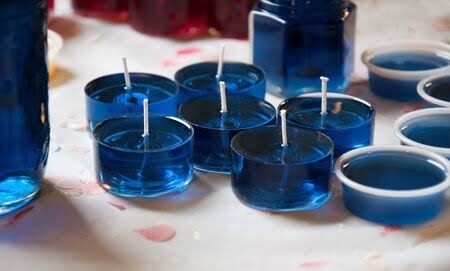Introduction
Candle making can be an enjoyable hobby, but it is important to remember the potential hazards that come with working with hot wax and flames. Hot wax can cause burns if direct contact is made, and the use of flames in candle-making means there is always a risk of fires occurring. In order to protect yourself from these risks, it is highly recommended that you wear protective gloves while candle making.
The correct type of glove depends on your individual needs, however most make use of materials such as cotton or leather that are designed to resist heat or fire. Gloves may also come in handy for those wishing to manipulate softer wax for decorative purposes such as sculpting. Not only does this make the process easier, but it helps to keep your hands free from any unwanted buildup or residue from the wax which can otherwise be difficult to remove.
Using long-handled tools such as wicks or thermometers can help to further reduce the risk of any potential harm occurring when manipulating liquid waxes or lit candles. Wearing gloves is an excellent way to ensure extra protection against burning yourself while creating your own candle creations – they provide an added layer of security while allowing you freedom and flexibility with your designs.
Benefits of Wearing Gloves for Candle Making
When it comes to candle making, there are quite a few benefits of wearing gloves to protect your hands from heated wax and scented oils. Even if you are an experienced chandler, it’s still important to wear gloves for this hobby as the temperature can quickly exceed well over 200 degrees Fahrenheit and safety should always be taken into consideration.
Here are some of the most important benefits of wearing gloves for candle making:
1. Protection from Heat: Wearing heat-resistant gloves will help keep your hands safe from hot wax and oils that can cause serious burns if direct contact is made with your skin. Be sure to check that the materials used in your candles do not cause damage when they become heated.
2. Color Fastness: If you plan on working with sensitive dyes or glitters, it’s a good idea to use gloves to keep them secured. Gloves will also keep your skin clean and free from color stains as you work with food-safe dyes or other additives in wax.
3. Odor Neutralization: When handling scented candles, gloves can help keep strong odors off your hands while helping preserve the strength and fragrance of the scent while melting or pouring wax in molds. You’ll also have an easier time reaching the bottom of containers without staining or tainting their contents.
4. Sanitation & Hygiene: Lastly, wearing rubber or plastic gloves is extremely hygienic when you’re working with multiple batches of different products in one day – such as essential oils and fragrances – as this helps prevent cross-contamination between batches during storage, cleaning or pouring activities. Gloves also make cleanup much easier by preventing sticky wax residue build up on your skin and nails!
Types of Gloves
Latex Gloves – Latex gloves are a popular choice for candle makers because they are inexpensive, comfortable to wear and easy to find. They come in a variety of sizes and colours. They also provide good protection against hot wax but may need to be replaced often as they can tear easily if they come into contact with sharp edges or rough surfaces.
Vinyl Gloves ” Vinyl gloves are also popular among candle makers due to their cost effectiveness, comfort and ease of use. Their biggest advantage is that they offer excellent protection against hot wax as opposed to latex gloves. The disadvantage is that vinyl gloves tend to be more slippery than latex, making them less useful when it comes to handling wicks and pouring candles.
Leather Gloves ” Leather gloves offer superior heat resistance, making them ideal for manipulating hot wax and pouring large batches of candles quickly and safely. However, leather is much more expensive than other types of gloves, so it may not be a viable option for those on tight budgets. Additionally, the seams on leather gloves can fray if exposed to extreme heat and temperatures over time, so proper care should be taken when using these gloves in candle making projects.
Cleaning Wax Off Gloves
When it comes to cleaning wax from gloves used for candle making, many people resort to using hot water and soap combined with either scrubbing or harsh chemicals. While these methods work well in most cases, there are a few other solutions that are easier on the gloves while still being effective. For instance, if your gloves have been exposed to a large amount of wax, you might consider putting them on after wetting them with warm water and then wiping off any excess wax with a microfiber cloth or cotton towel. This helps remove the bulk of the wax before you begin scrubbing with a mild detergent and hot water. Another trick is to put your gloves in the freezer for fifteen minutes or so which will cause the wax to harden and become brittle. To remove any stubborn bits of hardened wax, use an old toothbrush or nail brush to gently scrub away at it until all of it is removed. If all else fails, you can also use some cases petroleum jelly on the area prior to washing; this method should help loosen up any stuck-on residue and make cleaning significantly simpler.
Shopping Tips
Finding The Right Fit: When shopping for gloves specifically meant for candle making, it is important to find the right fit. Before purchasing the hand protection, take detailed measurements of your hands – including length, circumference, and width – and compare them to the size chart of your product. Additionally, make sure that they offer flexibility and mobility so you can easily maneuver around your materials.
Quality: Many companies have begun manufacturing eco-friendly versions of crafting supplies such as beeswax or latex gloves for candle making. It’s important to research quality prior to purchase; if you don’t understand the materials or their environmental impact, make sure to ask questions before committing to a purchase. Although reusable options are typically more expensive up front, they usually end up saving money in the long-run due to their durability and sustainability.
Safety Tips: Keep in mind that pouring any type of hot wax into a mold or container can result in serious burns if you’re not careful. While wearing gloves may help prevent direct contact with hot wax or melted metal containers, it only provides a limited degree of protection. To stay safe, always practice safety first ” always keep an eye on temperatures and find alternate methods in which you can pour wax safely while protecting yourself from potential danger.
Conclusion
Wearing gloves when making candles is essential for protecting your skin from wax splatters and burns. By using gloves you also minimize the risk of wax contaminating other candle-making supplies, allowing for a higher quality candle every time. Additionally, gloves have several safety advantages in that they can help prevent you from accidentally coming into contact with hot wax, reduce skin irritation often caused by additives and fragrance oils, and offer an extra layer of protection if you’re afforded the opportunity to handle a smoking wick or flame.
Ultimately, opting to wear gloves while making candles is a good practice regardless of experience level. This safety measure allows one to interact confidently with any potentially harmful substances during the entire process as well as enjoy long-term success when crafting quality products. Moving forward, we recommend wearing durable, heat-resistant gloves before each and every session to ensure optimal product confidence and satisfaction with each candle created.

Welcome to my candle making blog! In this blog, I will be sharing my tips and tricks for making candles. I will also be sharing some of my favorite recipes.


